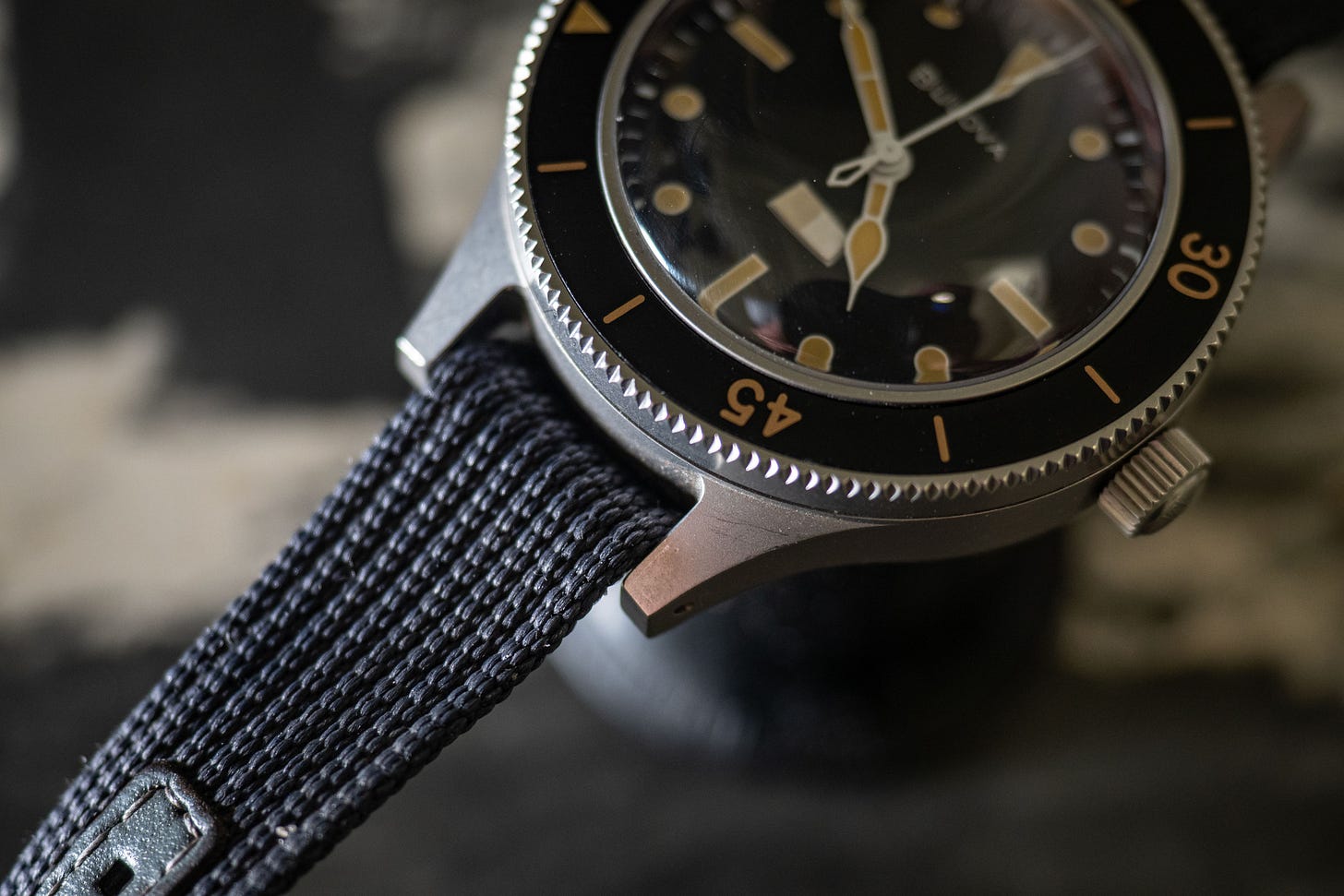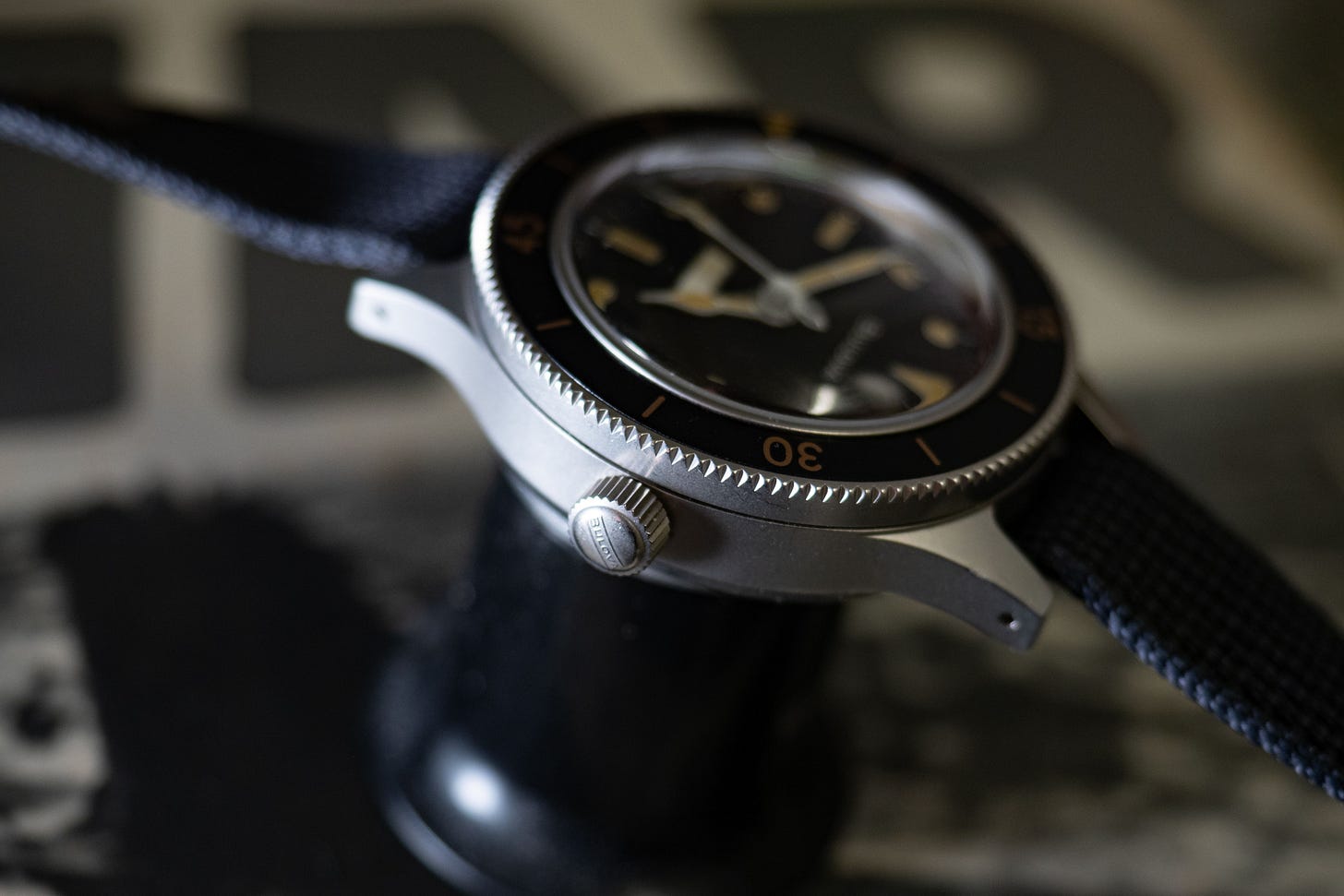Late Night Thoughts On The Bulova MIL-SHIPS-W-2181, And Monotony In Watch Design
Daring to be different can get you a lot of flak.
When the Bulova MIL-SHIPS-W-2181 came out in 2021, it was notable for several things, one of which was that it was the first actual production by Bulova of a watch which had until then only existed as an extremely rare prototype. The short version of the origin story is that the MIL-SHIPS-W-2181 is the modern version of a watch originally created as a prototype in the 1950s, as part of an attempt by Bulova to win a Navy contract for a diver’s watch for underwater combat operations. The basic requirements were by-now familiar features in dive watches: a bezel that couldn’t be accidentally jarred out of position; water resistance; and excellent legibility under poor visibility conditions.
The watch was never actually produced – there is some speculation that the small number the Navy would have ended up ordering made the game not worth the candle – but in 2019, Bulova, working with dive watch collector and enthusiast Adam Victor, went ahead and put the watch into production. The production model came in two versions, one with a Sellita movement in a limited edition, and one with a Miyota caliber which is still available in Bulova’s Archive Collection.
As you might expect from a watch originally designed in the 1950s there were some, by today’s standards, rather anachronistic features. The first was the rotating bezel, which is bidirectional, but which can only be rotated if you unlock it by pushing down (the bezel rotates smoothly without any clicks but locks into a position directly opposite a minute hash mark when released). Most modern dive watch manufacturers with few exceptions have transitioned away from locking bezels to the unidirectional bezels we’re all familiar with. The second feature – and I use the word advisedly – was the lug width. Bulova opted to do a more or less direct copy-paste of certain aspects of the design, and the production model (the non-limited version) is 41mm x 14.5mm, which is the same diameter as the original but 1.5mm thicker (the original, one of which was sold at Antiquorum in 2010, was 13mm thick). This is partly thanks to the domed sapphire crystal.
There were a lot of reservations expressed about the lug width, however; at 16mm this is pretty narrow for modern tastes, although the original had 16mm lugs as well.
But I think that in this case Bulova made the right call. I have very little experience wearing vintage dive watches, especially of this age, of any kind, but the smaller lug width and thinner strap give the watch an unusual and very distinctive look and feel. While upping the lug width to 18mm or 20mm would have given the watch a more contemporary feel, I think it would also have taken a bit away from the personality of the watch and made it a little less interesting to wear – it would have, it seems to me, have started to become just another vaguely vintage-adjacent modern dive watch.
There is a certain pressure, especially in dive watch design (to make a feeble pun) to adhere to a fairly narrow set of specifications and as a result there is a tendency for modern dive watches to look more alike than not. This doesn’t necessarily mean lack of imagination. It is not the job of a dive watch, fundamentally, to be an exercise in out-of-the-box design language; they are, more than most watches, designed to serve a certain purpose in a specific environment and for all that they have been functionally superseded by modern dive computers it is still nice that their look and feel generally still reflect functional considerations.
That said, I like the MIL-SHIPS-W-2181 the way it is. Machines meant to serve a purpose tend to converge on certain similarities; daily driver cars these days are all shaped by the remorseless invisible hand of the wind tunnel; air superiority fighters have all converged on similar designs as well and with good reason; so have submarines and the list goes on and on. In biology this is called convergent evolution – cephalopods (squid, octopus) diverged from vertebrate lineages nearly half a billion years ago but our eyes are remarkably similar.
This makes it all the more enjoyable to have a functional machine that is a little bit of an oddball. The MIL-SHIPS is just enough away from run-of-the-mill dive watch design that it makes you see the whole dive watch genre anew. Paradoxically enough, despite the fact that it’s a watch that was designed at the very beginning of the recreational dive watch era, it feels fresh and fun to wear in a way that many modern dive watches don’t.






Hi Jack, Another excellent piece of writing. Did you really mean "one of which was sold at Antiquorum in 2010, was 13mm in diameter)". My eyesight is not what it used to be but even when it was good 13mm would be to small for me to read😂
I'm an avid swimmer and have used many watches in the pool, including a SKX007, Submariner and a Seamaster Pro 300m; however the one have used now for several years is the Citizen Orca. By not conforming to most typical dive watch designs, it ends up being the most legible and reliable I have ever used.